
The black toad, also known as the Inyo toad or Deep Springs toad, is a true toad that lives only in scattered oases in the Deep Springs Valley of Inyo County, California. In fact, its original scientific name, Bufo exsul, means "exiled toad," which refers to its species' isolation in a tiny spot in the high desert wilderness of the Californian Great Basin.

The Hine's emerald is an endangered dragonfly species found in the United States and Canada. Populations exist in Illinois, Michigan, Missouri, Ontario, and Wisconsin. Larvae are found in shallow, flowing water in fens and marshes, and often use crayfish burrows. Major threats to the species include habitat loss and alteration, and the species is legally protected in both the United States and Canada.
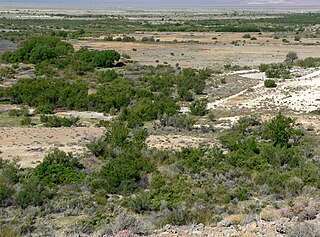
The Ash Meadows National Wildlife Refuge is a protected wildlife refuge located in the Amargosa Valley of southern Nye County, in southwestern Nevada. It is directly east of Death Valley National Park, and is 90 mi (140 km) west-northwest of Las Vegas.

The Devils Hole pupfish is a critically endangered species of the family Cyprinodontidae (pupfishes) found only in Devils Hole, a water-filled cavern in the US state of Nevada. It was first described as a species in 1930 and is most closely related to C. nevadensis and the Death Valley pupfish. The age of the species is unknown, with differing analyses offering ranges between one thousand and sixty thousand years. It is a small fish, with maximum lengths of up to 30 mm (1.2 in). Individuals vary in coloration based on age and sex: males are bright metallic blue while females and juveniles are more yellow. A defining trait of this species is its lack of pelvic fins. The pupfish consumes nearly every available food resource at Devils Hole, including beetles, snails, algae, and freshwater crustaceans, with diet varying throughout the year. It is preyed on by the predaceous diving beetle species Neoclypeodytes cinctellus, which was first observed in Devils Hole in 1999 or 2000. Reproduction occurs year-round, with spikes in the spring and fall. Females produce few eggs, though, and the survivorship from egg to adult is low. Individuals live 10–14 months.

The Seney National Wildlife Refuge is a managed wetland in Schoolcraft County in the U.S. state of Michigan. It has an area of 95,212 acres (385 km2). It is bordered by M-28 and M-77. The nearest town of any size is Seney, Michigan. The refuge contains the Seney Wilderness Area and the Strangmoor Bog National Natural Landmark within its boundaries.
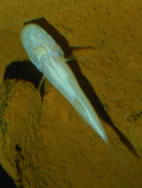
The Alabama cavefish is a critically endangered species of amblyopsid cavefish found only in underground pools in Key Cave, located in northwestern Alabama, United States in the Key Cave National Wildlife Refuge. It was discovered underneath a colony of gray bats in 1967 by researchers Robert A. Kuehne and John E. Cooper and scientifically described in 1974.
Grays Lake is a wetland in Idaho, United States. It lies in Bonneville County and Caribou County. Grays Lake National Wildlife Refuge was established in the area in 1965. Ranching is the predominant use of surrounding lands.

The bonytail chub or bonytail is a cyprinid freshwater fish native to the Colorado River basin of Arizona, California, Colorado, Nevada, New Mexico, Utah and Wyoming in the southwestern United States; it has been extirpated from the part of the basin in Mexico. It was once abundant and widespread in the basin, its numbers and range have declined to the point where it has been listed as endangered since 1980 (ESA) and 1986 (IUCN), a fate shared by the other large Colorado basin endemic fish species like the Colorado pikeminnow, humpback chub, and razorback sucker. It is now the rarest of the endemic big-river fishes of the Colorado River. There are 20 species in the genus Gila, seven of which are found in Arizona.

The boulder darter is a species of freshwater ray-finned fish, a darter from the subfamily Etheostomatinae, part of the family Percidae, which also contains the perches, ruffes and pikeperches. It is endemic to Alabama and Tennessee in the United States, where it occurs in the Elk River system and Shoal Creek. It is found in small rivers and fast-flowing streams, at least 2 ft (0.6 m) deep, with boulders or a rocky base. It feeds on aquatic insect larvae but little is known of its natural history. The population trend of this fish is unknown but it is affected by a rise in siltation and the impoundment of water within its range by the building of dams. The International Union for Conservation of Nature has assessed its conservation status as being "vulnerable".

Gammarus desperatus, commonly known as Noel's Amphipod, is a species of small, amphipod crustacean in the family Gammaridae.
The San Luis National Wildlife Refuge Complex is located in the northern San Joaquin Valley, within Merced County and Stanislaus County of California. The complex, with four federal National Wildlife Refuges, is managed by the U.S Fish & Wildlife Service.

Nitrophila mohavensis is a rare species of flowering plant in the family Amaranthaceae known by the common name Amargosa niterwort. It is endemic to Nye County in southwestern Nevada and Inyo County, in eastern California.
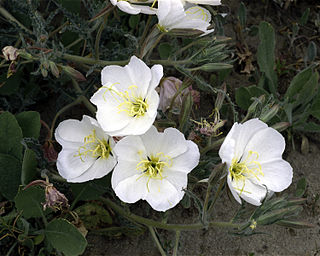
Oenothera deltoides subsp. howellii, the Antioch Dunes evening primrose, is an endangered subspecies of plant in the family Onagraceae, genus Oenothera, and species Oenothera deltoides.

Astragalus phoenix is a rare species of milkvetch known by the common name Ash Meadows milkvetch. It is endemic to Nye County, in southwestern Nevada.

Cyprinodon nevadensis is a species of pupfish in the genus Cyprinodon. The species is also known as the Amargosa pupfish, but that name may also refer to one subspecies, Cyprinodon nevadensis amargosae. All six subspecies are or were endemic to very isolated locations in the Mojave Desert of California and Nevada.

Mentzelia leucophylla, known by the common name Ash Meadows blazingstar, is a rare species of flowering plant in the Loasaceae. It is endemic to southwestern Nevada, in the Western United States.
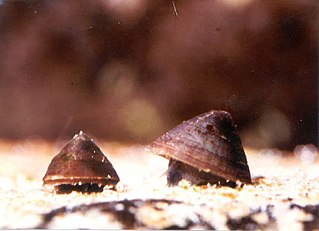
Idaholanx fresti, the Banbury Springs limpet or Banbury Springs lanx, is a rare species of freshwater snail, an aquatic gastropod mollusc in the family Lymnaeidae. It is the only species in the genus Idaholanx. First discovered in 1988, the species was formally described and named in 2017.
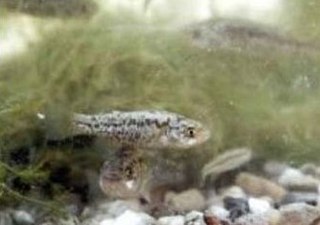
Empetrichthys latos is a rare species of fish in the family Goodeidae, the splitfins. It is known by the common names Pahrump poolfish and Pahrump killifish, the former being more correct today. It is endemic to Nevada in the United States, where it was limited to the Pahrump Valley near the California border. It nearly became extinct due to habitat destruction and no longer occurs there. It is a federally listed endangered species of the United States. The Pahrump Poolfish is long-lived for a small-bodied fish, with ages up to 10 years for females and 7 years for males documented.

Cicindela dorsalis dorsalis, commonly known as the Northeastern beach tiger beetle, is the largest subspecies of Eastern beach tiger beetle. In 2012, Cicindela dorsalis dorsalis was reclassified under the name Habroscelimorpha dorsalis dorsalis, but the names are used synonymously in recently published literature. Fitting to its name, the Northeastern beach tiger beetle dwells along the U.S. northeast coast in small sand burrows. The beetle is diurnal and can be spotted by its light tan coloring with dark lines and green hues on its thorax and head.
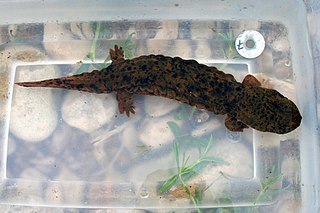
The Ozark hellbender is a subspecies of the hellbender, strictly native to the mountain streams of the Ozark Plateau in southern Missouri and northern Arkansas. Their nicknames include lasagna lizard and snot otter. These large salamanders grow to average from 29-57 centimeters in length over a lifespan of 30 years. Ozark hellbenders are nocturnal predators that reside under large flat rocks and primarily consume crayfish and small fish. As of 2011, the U.S. Fish and Wildlife Service (USFWS) has listed the subspecies as endangered under the Endangered Species Act of 1973. The species population decline is caused by habitat destruction and modification, overutilization, disease and predation, and low reproductive rates. Conservation programs have been put in place to help protect the species.


















